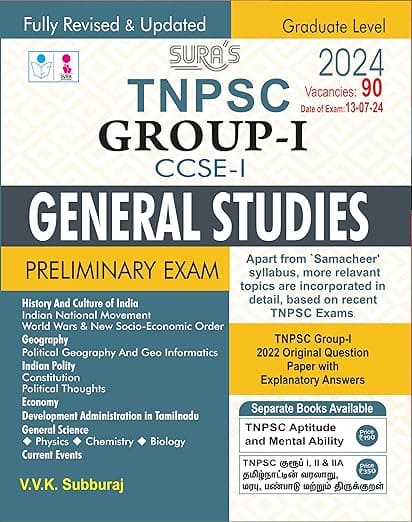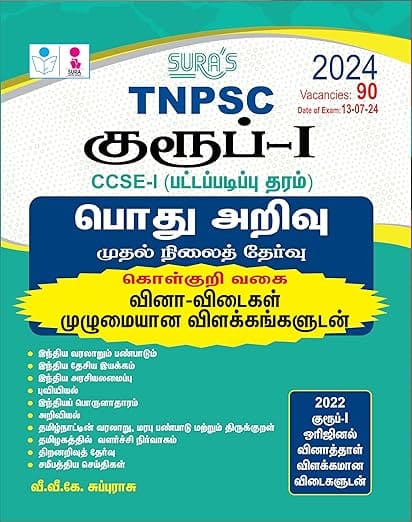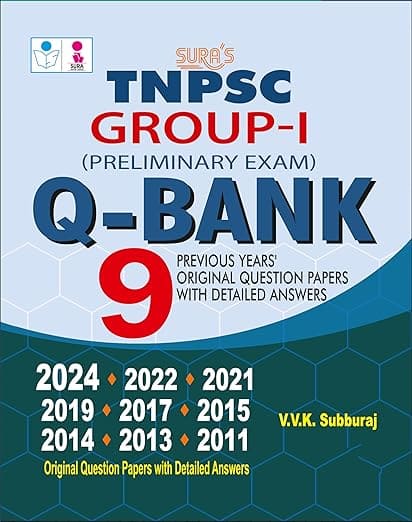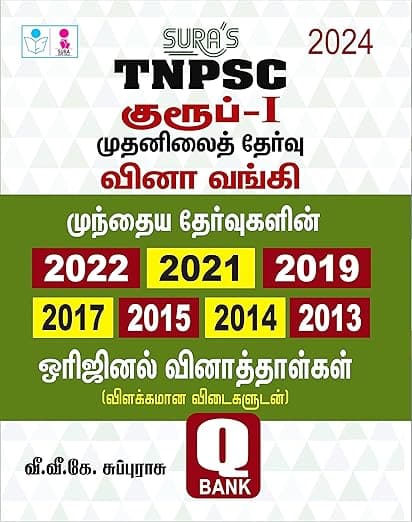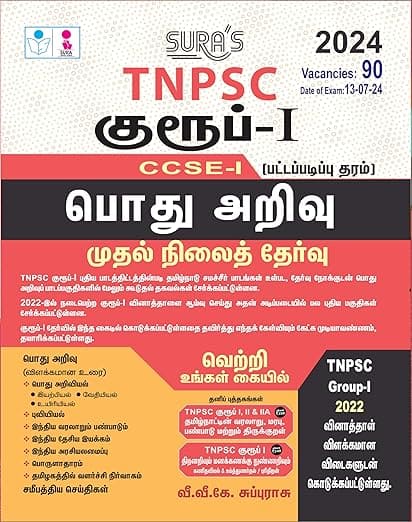Science : Term 3 Unit 2 : Animal Life
Unit 2
Animal Life

Learning Objectives
At the end of this lesson the students will be able to
* differentiate various habitats of animals
* understand the food procurement of animals
* identify the eating habits of animals in their surroundings
* know the mouthparts of birds and insects
* realize the importance of food chain and food web in the environment
Warm-up
Identify and write the names of the animals by using the keywords given.
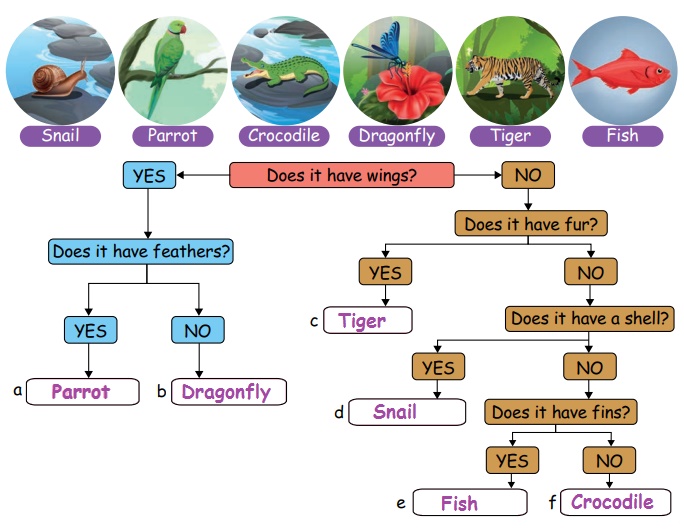
I. Animals in Different Environment
Our Earth provides place for lakhs and lakhs of animals to live. The living place of an animal or a plant is called habitat. The basic needs such as food, water, shelter and place to breed are found in a habitat.
Habitat can be as big as a forest or as small as a leaf. Animals live in different conditions. For example, whales live in sea (water) and foxes live in forest (land).
Land (Terrestrial) Habitat
Animals that live on land are called terrestrial animals. E.g., Ants, Cats and Lion. Some of the land habitats are:
1. Plains
2. Forests
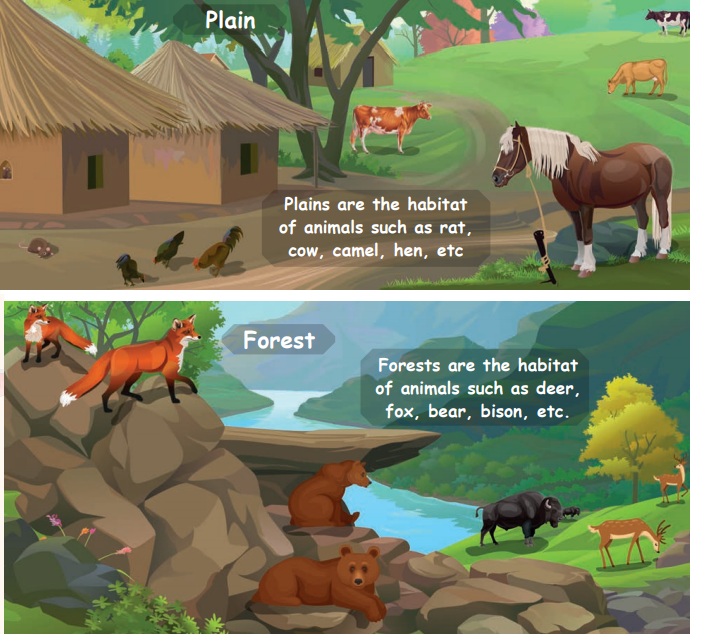
1. Plain
Plains are the habitat of animals such as rat, cow, camel, hen, etc
2. Forest
Forests are the habitat of animals such as deer, fox, bear, bison, etc.
Water (Aquatic) Habitat
Animals that live in water are called aquatic animals. E.g., Fish, Dolphin and Crab.
Water habitat is divided into two types:
1. Freshwater
2. Marine (Sea water)
Do you know?
World animal day is observed on 4th October.
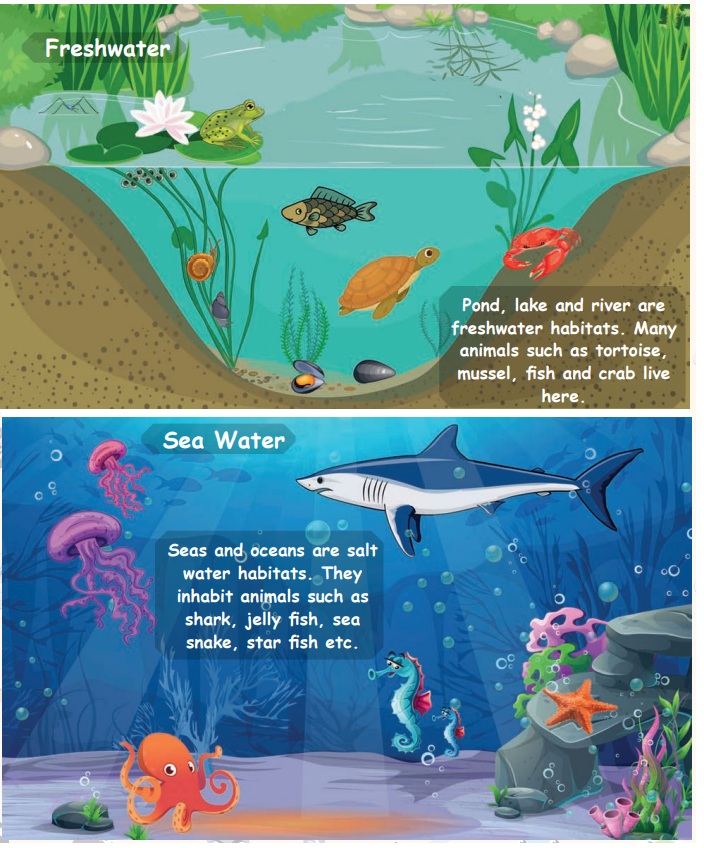
Fresh water
Pond lake and river are freshwater habitats. Many animals such as tortoise, mussel, fish and crab live here.
Sea Water
Seas and oceans are salt water habitats. They inhabit animals such as shark, jelly fish, sea snake, star fish etc.
Let Us Connect
Link the animals that live in water and live on land.
Pig, Mussel, Deer, Starfish, Dog, Whale, Frog, Tiger, Monkey, Crab, Camel, Horse, Seahorse, Lion, Elephant, Cow
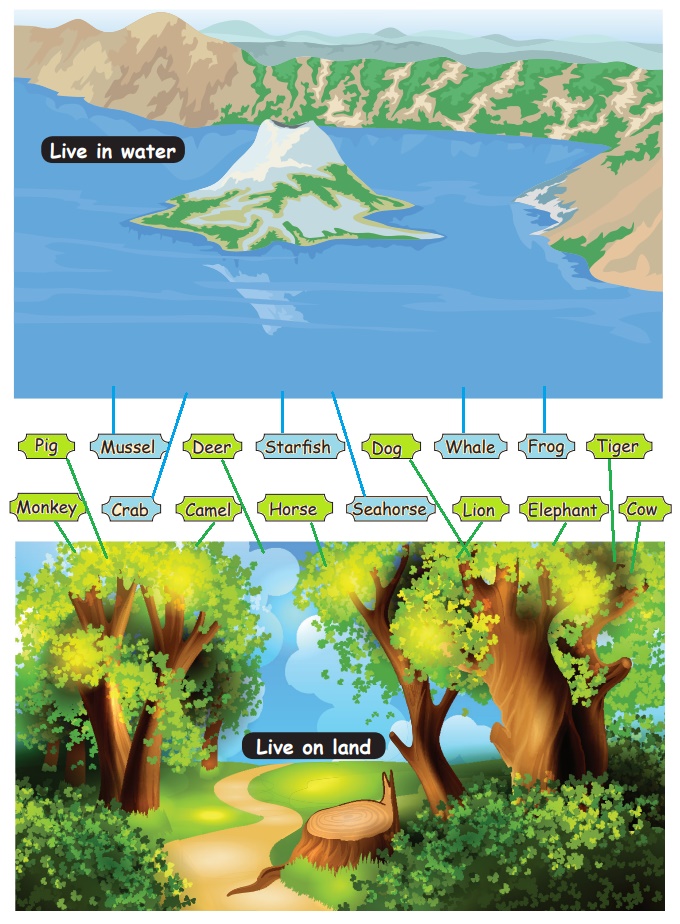
Let Us Help
There is a zoo near your town. Due to some reasons, they have to take the animals back to their habitat. Where will they take each of the following animals?
(Tiger, Crab, Turkey, Giraffe, Cat, Fish, Bear, Donkey, Camel, Crow, Zebra, Duck, Elephant, Tortoise, Pig, Peacock, Lion)
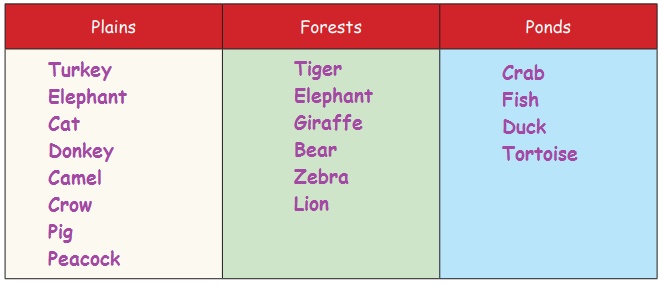
Plains: Turkey, Elephant, Cat, Donkey, Camel, Crow, Pig, Peacock
Forests: Tiger, Elephant, Giraffe, Bear, Zebra, Lion
Ponds: Crab, Fish, Duck, Tortoise
Let Us Find
A. Circle the odd one based on habitat.
a. Lion, Elephant, Monkey, Whale
b. Shark, Dog, Jelly fish, Star fish
B. Write the names of the animal with the help of the clues given.
(Penguin, Whale, Octopus, Duck)
1. Octopus has eight arms. It lives in the ocean. 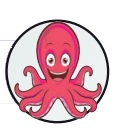
2. Penguin cannot fly, but it swims very well. 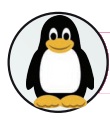
3. Whale is the largest animal in the sea. 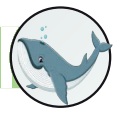
4. Duck is a common water bird. 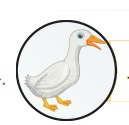
Let Us Do
Colour the animals that live in water.
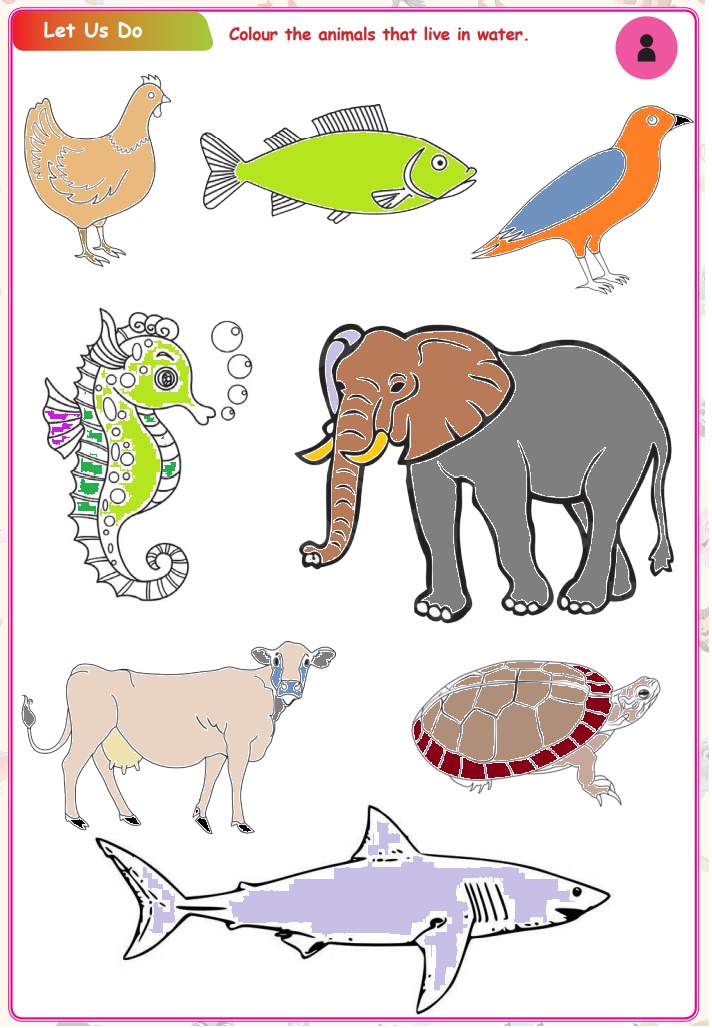
More to know
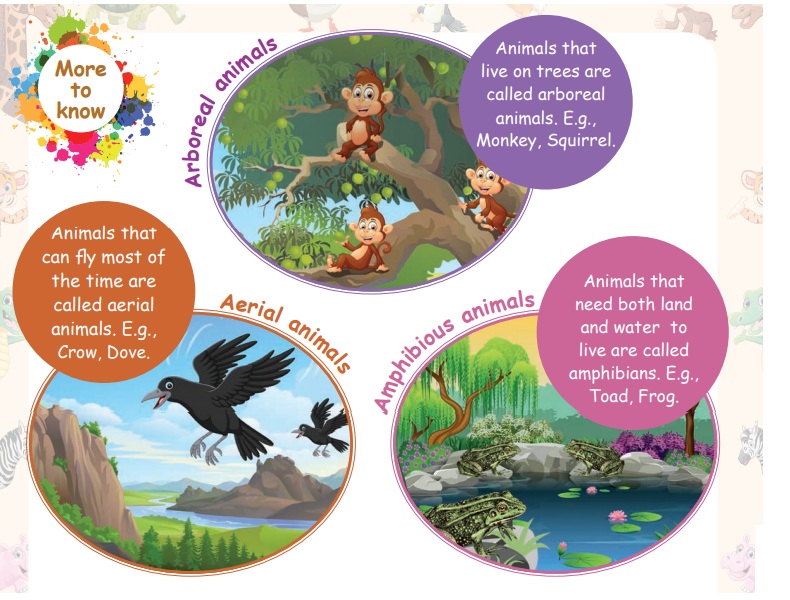
Arboreal animals
Animals that live on trees are called arboreal animals. E.g., Monkey, Squirrel.
Aerial animals
Animals that can fly most of the time are called aerial animals. E.g., Crow, Dove.
Amphibious animals
Animals that need both land and water to live are called amphibians. E.g., Toad, Frog.
Let Us Connect
Match the animals with their living place.
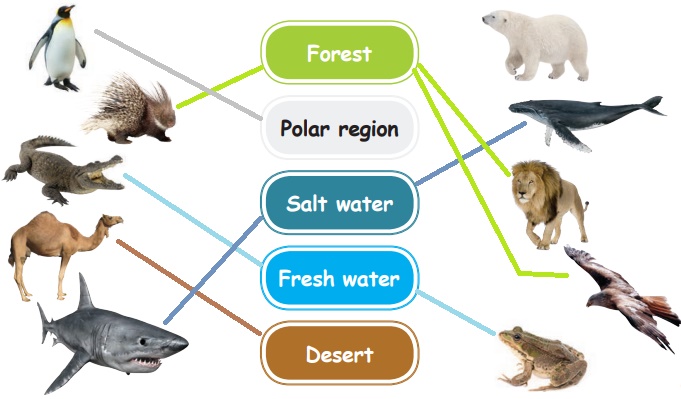
Let Us Connect
Match these animals with their homes.
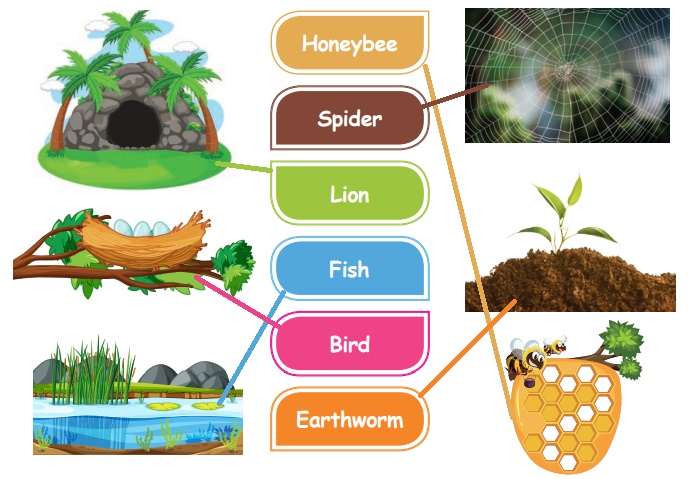
II. How do animals get their foods?
Write the foods of given animals using the following words.
(Carrot, Deer, Milk, Grass, Grains)
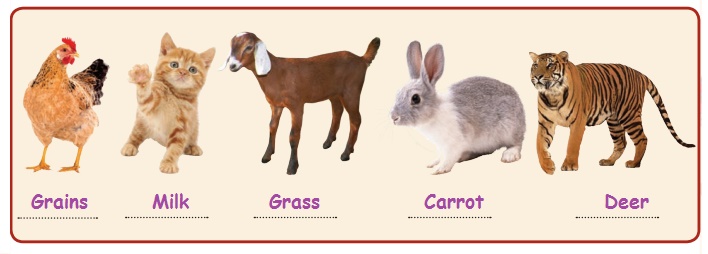
Think and share. Why should animals get food?
Animals cannot make their own food. They depend on plants or other plant-eating animals for their food. They move in search of food.
Let us discuss the following and complete the sentence.
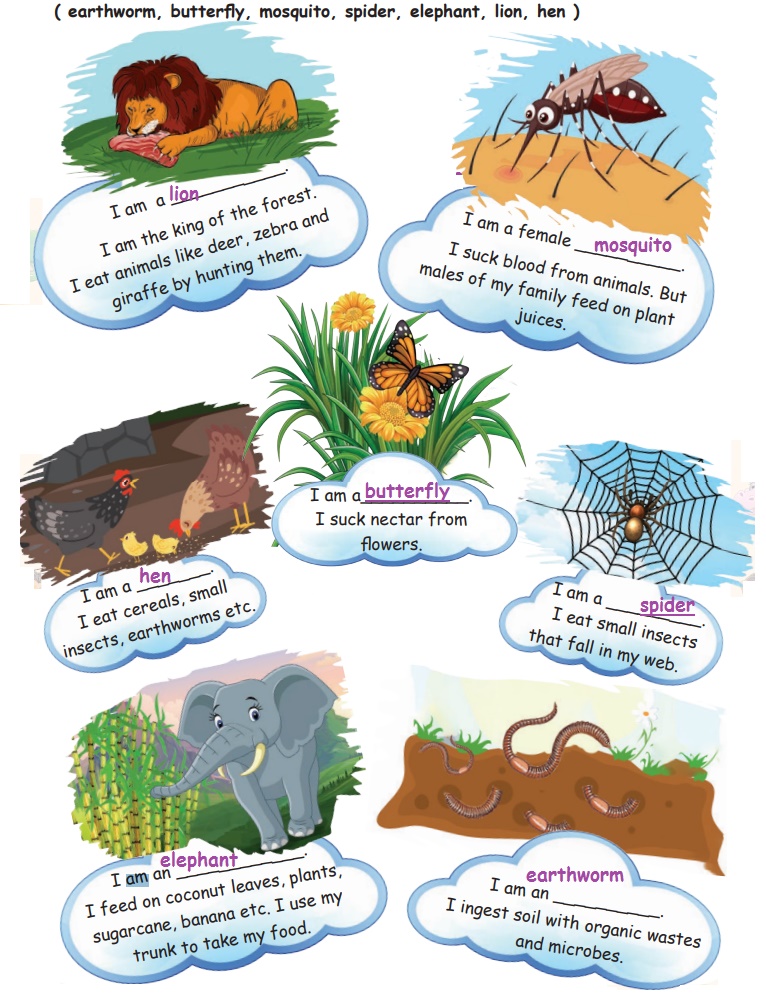
( earthworm, butterfly, mosquito, spider, elephant, lion, hen )
I am a lion.
I am the king of the forest. I eat animals like deer, zebra and giraffe by hunting them.
I am a female mosquito.
I suck blood from animals. But males of my family feed on plant juices.
I am a hen.
I eat cereals, small insects, earthworms etc.
I am a butterfly.
I suck nectar from flowers.
I am a spider.
I eat small insects that fall in my web
I am an elephant.
I feed on coconut leaves, plants, sugarcane, banana etc. I use my trunk to take my food.
I am an earthworm.
I ingest soil with organic wastes and microbes.
Let Us Connect
Help the animals to find their food. Use different colour for each animal.
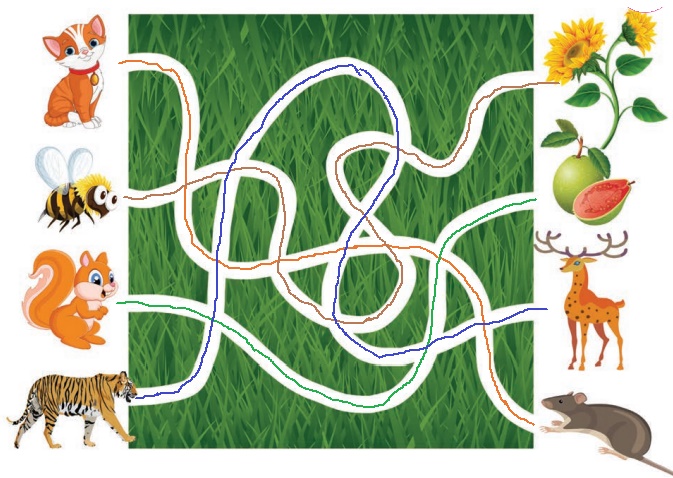
Let Us Do
Complete the worksheet using the following hints.
(Tiger, Lizard, Deer, Dove, Honeybee, Butterfly, Goat, Fox, Squirrel, Woodpecker )
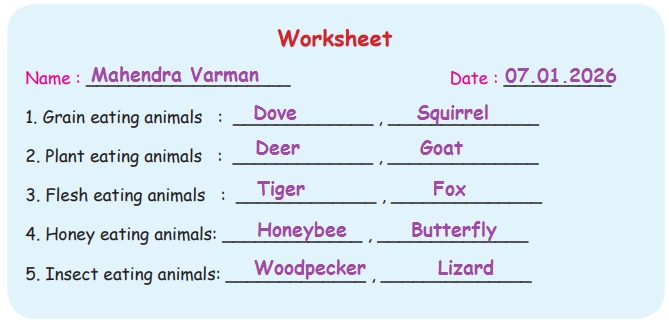
1. Grain eating animals : Dove, Squirrel
2. Plant eating animals : Deer , Goat
3. Flesh eating animals : Tiger, Fox
4. Honey eating animals : Honeybee, Butterfly
5. Insect eating animals : Woodpecker, Lizard
III. Classification of animals based on their eating habits
Do all animals eat the same type of food?
Have you ever seen a lion eating grass or a goat eating meat? Why do not animals eat all types of food? It is because different animals have different food habits.
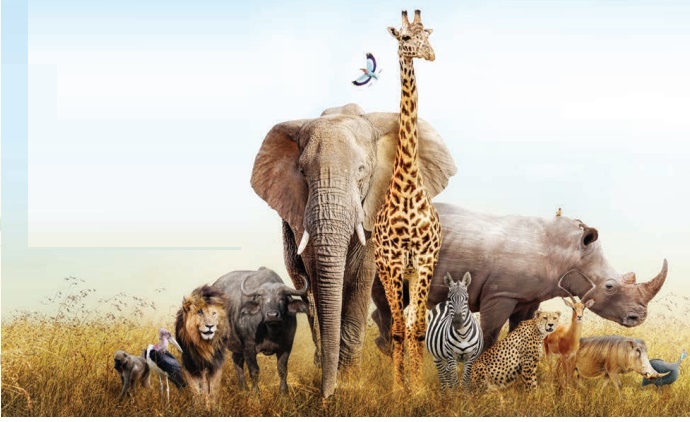
Herbivores
Animals that eat only plants are called herbivorous animals or herbivores (Plant eaters). E.g., Deer, Giraffe, Cow, Goat and Elephant. They have sharp, straight edged, flat front teeth called incisors to bite the grass and leaves.
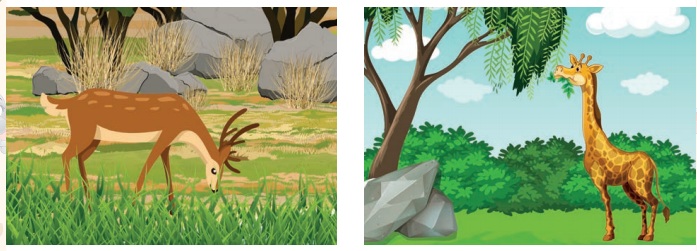
Let us think
Elephant is a herbivore. But its front teeth are not flat. How can we call them?
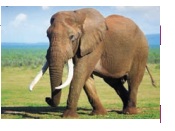
Answer: Tusks
Carnivores
Flesh eating animals are called carnivorous animals or carnivores. E.g., Hyena, Tiger, Lion, Cheetah and Seal. They have sharp, pointed teeth called canines. Canines are used to tear the flesh of animals.
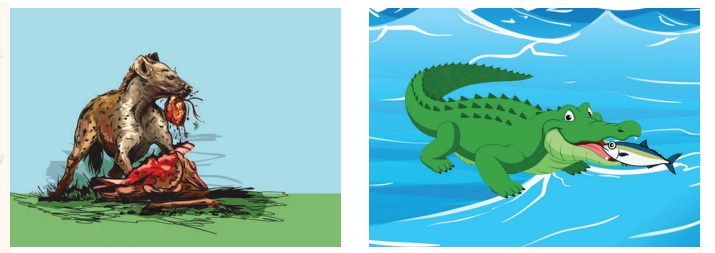
Forest – A natural home for wildlife
Omnivores
Some animals eat both plants and the flesh of other animals. These animals are called omnivorous animals or omnivores. E.g., Bear, Man, Crow, Hen and Fox. These animals have a combination of tearing, biting and grinding teeth.
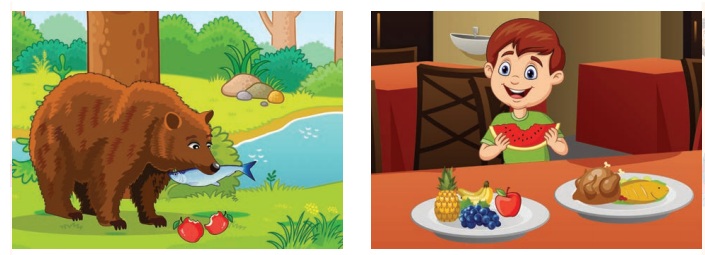
Think and Answer
You tell your friend that you are an omnivore. But he tells that he is an herbivore. It is right or wrong? How?
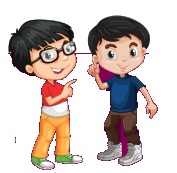
Answer: Yes, it is right. Because he eats only vegetarian meals
More to know
* Animals that hunt other animals are called predators
* Animals that are hunted are called prey.
Let Us Connect
Observe the pictures and draw a line to connect them to the appropriate jars.
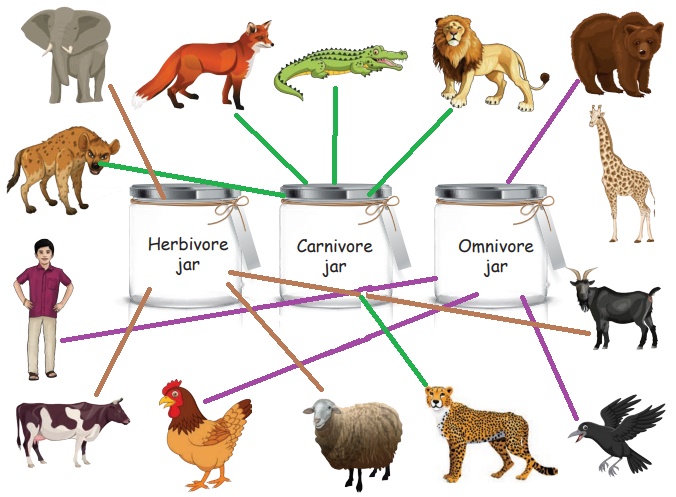
Do you know?
* An adult elephant can eat upto 136 kg of food in a day.
* Some of us have colourful fishes in our homes as pets. We keep them in small water tank known as aquariums.
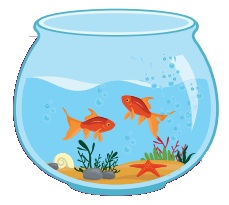
Let Us Find
Circle the foods that the animal will eat. You can choose more than one, if applicable.
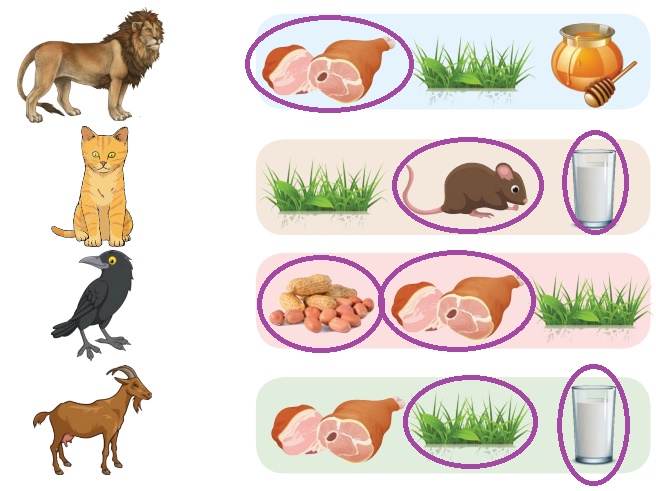
Let Us Find
From the given diagram, identify which animal group is represented by ‘B’ and write three examples of it.
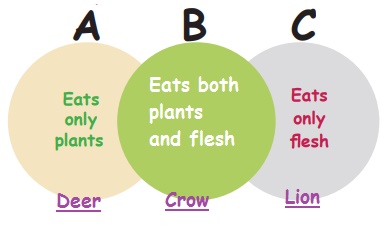
A: Eats only plants : Deer
B: Eats both plants and flesh: Crow
C: Eats only flesh: Lion
Let Us Flay
Play in pairs. Think of a wild animal. Give three hints to your friend about the animal and let him or her guess its name. Take turns.
IV. Mouth parts of animals
(Conversation between teacher and students)
Teacher : Do you know the parts in your mouth?
Pandiyan : Lips, teeth, tongue.
Teacher : Good. Do you know the use of teeth?
Vennila: They cut and chew the foodstuff.
Teacher : Fine. Are all the teeth have same size and shape?
Vasu: No, Madam.
Teacher : Yes. The teeth have different shape and size based on their functions. Today, we will learn more about these mouth parts. Mouth parts are different parts of the mouth that are adapted based on the nature of food that the animal eats.
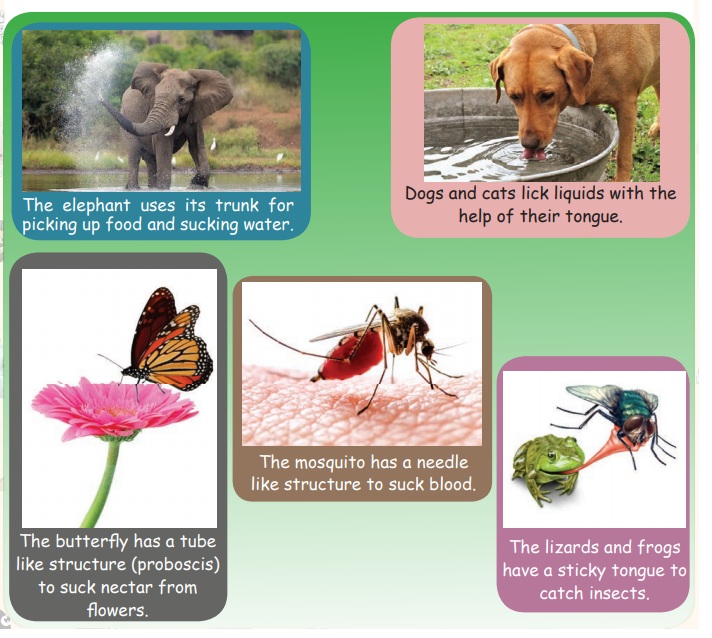
The elephant uses its trunk for picking up food and sucking water.
Dogs and cats lick liquids with the help of their tongue.
The butterfly has a tube like structure (proboscis) to suck nectar from flowers.
The mosquito has a needle like structure to suck blood.
The lizards and frogs have a sticky tongue to catch insects.
Watch and Learn
Look at flowering plants near your school or home. Watch the butterflies which visit those plants. Do they come at all times in a day? Do they sit still or fly from flower to flower?
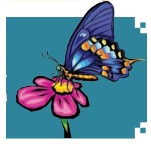
Answer: No, they don’t sit still. They fly from flower to flower.
Think and Answer
Have you ever wondered why birds have beaks of different shapes and sizes?
Answer: Yes, I have wondered why different birds have different types of beaks. It is a fact that beaks are adapted to the food habits of birds.
Beaks of Birds
Eagle
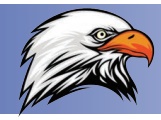
Eagle has strong, sharp, curved beak to catch prey and tear its flesh.
Kingfisher
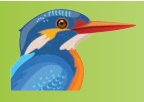
Fish-eating birds have spear-like beaks designed for stabbing fish.
Parrot
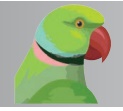
The hooked, sharp beak of parrot helps to collect and eat the grains.
Woodpecker
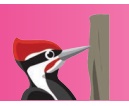
Strong chisel beak of woodpecker is used to make hole in the trees and catch small insects.
Sparrow
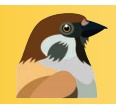
Sparrow has short, conical beak which helps to crack open the shells and extract the inner nut or seed.
Duck
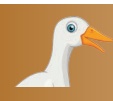
Duck has flat beak that helps to grip plant and insect from water.
Let Us Draw
1. Draw the beaks of birds which perform the following functions.
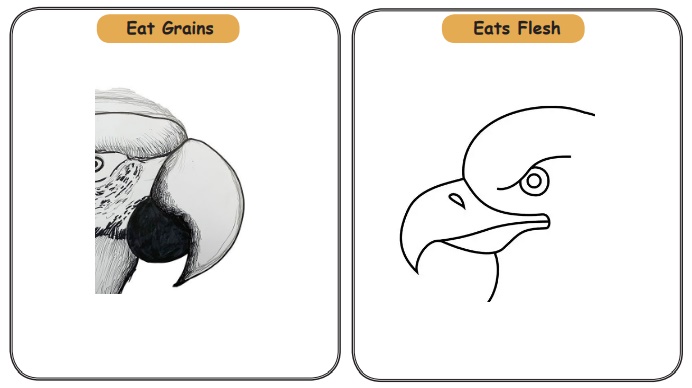
2. Draw and colour a parrot.
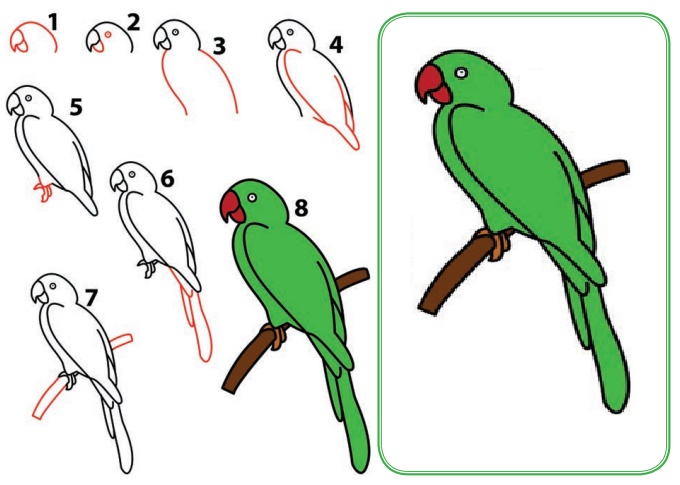
Let Us Find
Observe the picture and name the animals in it.
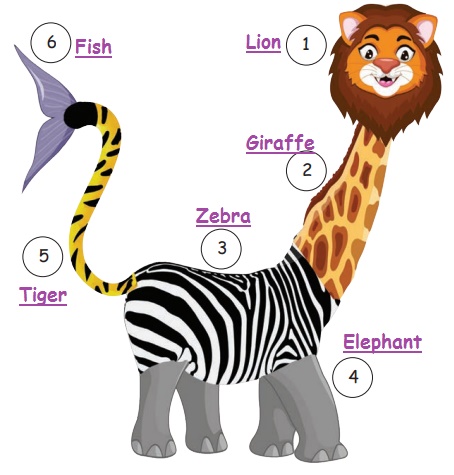
1. Lion
2. Giraffe
3. Zebra
4. Elephant
5. Tiger
6. Fish
V. Food Chain
When you look around you can see the following.
The grass is food for deer and deer is food for tiger.
Plants are food for grasshoppers and grasshoppers are food for bird.
From these examples, we observe that plants are food for many animals, which in turn become food for other animals.
Let us look at the picture below:

This is a food chain. It gives us information on how living things are related with one another by the food they eat. Here the grass is eaten by deer. The deer is eaten by the tiger.
A food chain usually starts with plants and ends with carnivores or omnivores.
Other examples for food chain.
1. Leaves→ Caterpillar →Hen→ Hawk
2. Grass →Grasshopper→ Rat→ Owl
Food Web
Every organism can feed on different kinds of food. So a single organism will be a part of many food chains. These food chains are interconnected to form a web.
Hence, a Food web is an interconnection of multiple food chains. Transfer of energy between organisms of different energy sources occurs through food web.
Example of food web
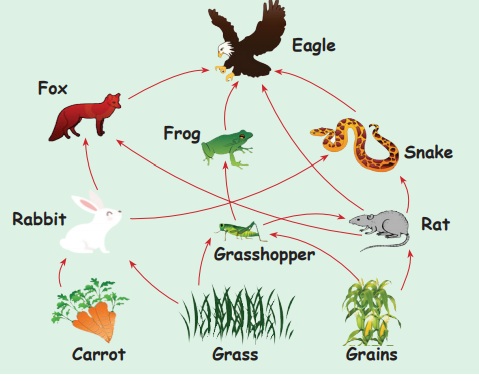
Try to Answer
1. Select the food chain that can exist in nature.
A.Grass → Wheat → Grasshopper → Frog → Snake
B.Grass → Rabbit → Fox → Lion
✔C.Wheat → Grasshopper → Snake→ Frog
2. Form any two food chains using the following.
(Grass, Tiger, Deer, Dolphin, Fish, Insect, Snail, Plant, Kingfisher)
Food chain 1: Grass → Deer → Tiger
Food chain 2: Insect → Fish → Kingfisher
Let Us Complete
Complete the food web.

EVALUATION
I. Choose and write the correct answer.
1. Mosquito sucks its food. Which of the animals given below suck their food?
a) Cockroach
b) Parrot
c) Butterfly
Answer : c) Butterfly
2. Bear sometimes eats pumpkin and sometimes eats fish. So, it is an _____.
a) Carnivore
b) Omnivore
c) Herbivore
Answer : b) Omnivore
3. A bird that has beak which helps it to crack open shells and eat the seed inside is
a) Sparrow
b) Owl
c) Kingfisher
Answer : a) Sparrow
4. Flesh eating animals have well developed __________.
a) Molars
b) Tusks
c) Canines
Answer : c) Canines
5. Elephant is a__________ .
a) Herbivore
b) Carnivore
c) Omnivore
Answer : a) Herbivore
6. Choose the carnivore.
a) Deer
b) Lion
c) Giraffe
Answer : b) Lion
7. In a food chain, a _________ can be placed immediately before a snake.
a) Eagle
b) Frog
c) Grass
Answer : b) Frog
8. Select the animal that has similar eating habit like a bear.
a) Camel
b) Deer
c) Hen
Answer : c) Hen
9. Find the odd one based on the habitat.
a) Deer
b) Fish
c) Fox
Answer : b) Fish
10. Which of the following has different eating habits compared to the others?
a) Elephant
b) Cow
c) Dog
Answer : c) Dog
II. Fill in the blanks.
1. A small habitat is leaf ( forest / leaf ).
2. Butterflies suck nectar ( nectar / water ) from flowers.
3. Chisel beak is present in woodpecker ( sparrow / woodpecker ).
4. The parrot eats nuts ( rats / nuts ).
5. A food chain always begins with plants ( plants / animals ).
III. Answer the following questions.
1. Land and water are common habitats. What is a habitat?
The living place of an animal or a plant is called habitat.
2. Give two examples for each.
a. Terrestrial Animal: Lion , Cat
b. Aquatic Animal : Fish, Crab
3. Why animals move from place to place?
Animals move from place to place in search of food.
4. Nectar is the food of butterfly. Then, what is the food of earthworm?
Organic waste in the soil is the food of earthworm.
5. Differentiate a herbivore from a carnivore.
Herbivores
1. They eat only plants
2. They have sharp, straight edge flat called incisors
3. Eg: Deer, Cow
Carnivores
1. They eat only flesh of other animals.
2. They have sharp, pointed teeth called canines
3. Eg: Tiger, Lion
6. Is human an omnivore or carnivore?
Human is an omnivore.
7. Give an example of a food chain.
Leaves → Caterpillar → Hen → Hawk
8. Choose the correct food chain from the following.
a. Leaves → Bird→ Insect
b. Insect→ Leaves →Bird
c. Leave→ Insect → Bird
Answer : c. Leave→ Insect → Bird
IV. Project
Collect and paste the pictures of plant eating animals and flesh eating animals.
Warm-up
Identify and write the names of the animals by using the keywords given.

Let Us Connect
Link the animals that live in water and live on land.
Pig, Mussel, Deer, Starfish, Dog, Whale, Frog, Tiger, Monkey, Crab, Camel, Horse, Seahorse, Lion, Elephant, Cow

Let Us Help
There is a zoo near your town. Due to some reasons, they have to take the animals back to their habitat. Where will they take each of the following animals?
(Tiger, Crab, Turkey, Giraffe, Cat, Fish, Bear, Donkey, Camel, Crow, Zebra, Duck, Elephant, Tortoise, Pig, Peacock, Lion)

Plains: Turkey, Elephant, Cat, Donkey, Camel, Crow, Pig, Peacock
Forests: Tiger, Elephant, Giraffe, Bear, Zebra, Lion
Ponds: Crab, Fish, Duck, Tortoise
Let Us Find
A. Circle the odd one based on habitat.
a. Lion, Elephant, Monkey, Whale
b. Shark, Dog, Jelly fish, Star fish
B. Write the names of the animal with the help of the clues given.
(Penguin, Whale, Octopus, Duck)
1. Octopus has eight arms. It lives in the ocean. 
2. Penguin cannot fly, but it swims very well. 
3. Whale is the largest animal in the sea. 
4. Duck is a common water bird. 
Let Us Do
Colour the animals that live in water.

Let Us Connect
Match the animals with their living place.

Let Us Connect
Match these animals with their homes.

Write the foods of given animals using the following words.
(Carrot, Deer, Milk, Grass, Grains)

Think and Share.
Why should animals get food?
Animals cannot make their own food. They depend on plants or other plant-eating animals for their food. They move in search of food.
Let us discuss the following and complete the sentence.

( earthworm, butterfly, mosquito, spider, elephant, lion, hen )
I am a lion.
I am the king of the forest. I eat animals like deer, zebra and giraffe by hunting them.
I am a female mosquito.
I suck blood from animals. But males of my family feed on plant juices.
I am a hen.
I eat cereals, small insects, earthworms etc.
I am a butterfly.
I suck nectar from flowers.
I am a spider.
I eat small insects that fall in my web
I am an elephant.
I feed on coconut leaves, plants, sugarcane, banana etc. I use my trunk to take my food.
I am an earthworm.
I ingest soil with organic wastes and microbes.
Let Us Connect
Help the animals to find their food. Use different colour for each animal.

Let Us Do
Complete the worksheet using the following hints.
(Tiger, Lizard, Deer, Dove, Honeybee, Butterfly, Goat, Fox, Squirrel, Woodpecker )

1. Grain eating animals : Dove, Squirrel
2. Plant eating animals : Deer , Goat
3. Flesh eating animals : Tiger, Fox
4. Honey eating animals : Honeybee, Butterfly
5. Insect eating animals : Woodpecker, Lizard
Let us think
Elephant is a herbivore. But its front teeth are not flat. How can we call them?

Answer: Tusks
Think and Answer
You tell your friend that you are an omnivore. But he tells that he is an herbivore. It is right or wrong? How?

Answer: Yes, it is right. Because he eats only vegetarian meals
Let Us Connect
Observe the pictures and draw a line to connect them to the appropriate jars.

Let Us Find
Circle the foods that the animal will eat. You can choose more than one, if applicable.

Let Us Find
From the given diagram, identify which animal group is represented by ‘B’ and write three examples of it.

A: Eats only plants : Deer
B: Eats both plants and flesh: Crow
C: Eats only flesh: Lion
Let Us Play
Play in pairs. Think of a wild animal. Give three hints to your friend about the animal and let him or her guess its name. Take turns.
Watch and Learn
Look at flowering plants near your school or home. Watch the butterflies which visit those plants. Do they come at all times in a day? Do they sit still or fly from flower to flower?

Answer: No, they don’t sit still. They fly from flower to flower.
Think and Answer
Have you ever wondered why birds have beaks of different shapes and sizes?
Answer: Yes, I have wondered why different birds have different types of beaks. It is a fact that beaks are adapted to the food habits of birds.
Let Us Draw
1. Draw the beaks of birds which perform the following functions.

2. Draw and colour a parrot.

Let Us Find
Observe the picture and name the animals in it.

1. Lion
2. Giraffe
3. Zebra
4. Elephant
5. Tiger
6. Fish
Try to Answer
1. Select the food chain that can exist in nature.
A. Grass → Wheat → Grasshopper → Frog → Snake
B. Grass → Rabbit → Fox → Lion
✔C.Wheat → Grasshopper → Snake→ Frog
2. Form any two food chains using the following.
(Grass, Tiger, Deer, Dolphin, Fish, Insect, Snail, Plant, Kingfisher)
Food chain 1: Grass → Deer → Tiger
Food chain 2: Insect → Fish → Kingfisher
Let Us Complete
Complete the food web.


